The cuisine of Georgia and the Caucasus offers a lot of inspiration for the adventurous cook and forager, and Tkemali sauce (Tee-guh-molly) is one of the crown jewels of their cuisine—a sort of ketchup like condiment rich with garlic, hot chilies and spices like fenugreek and coriander that would make a shoe taste good.
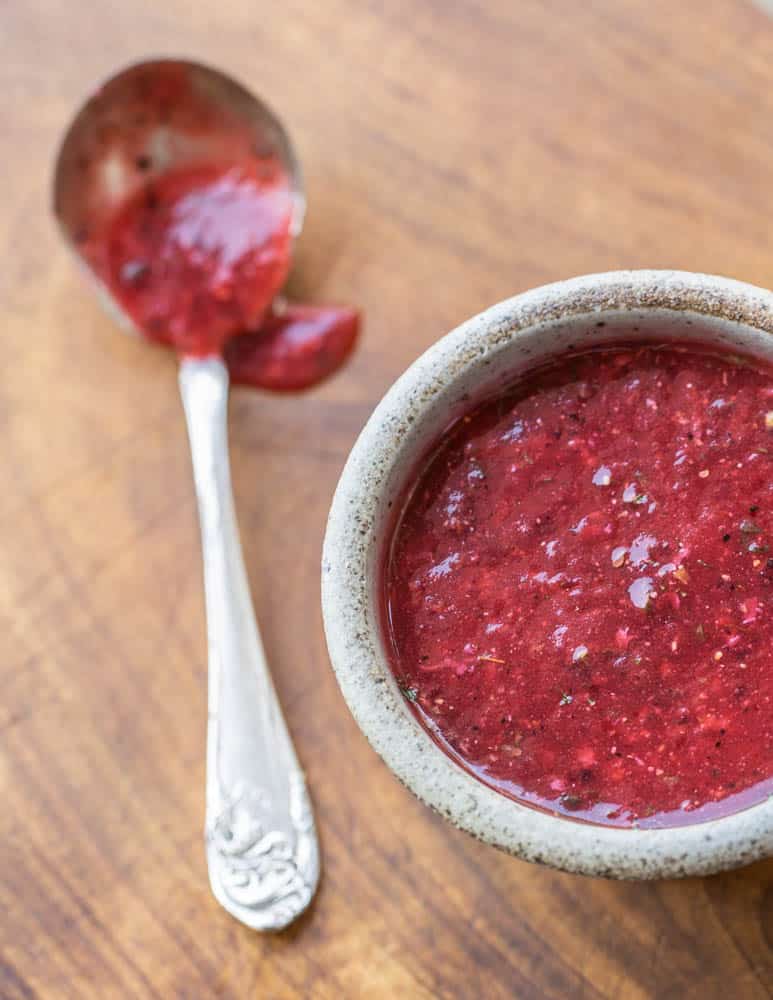
It makes for a great highbush cranberry recipe, and, unlike other more common preservation methods like jelly and jam, doesn't include a lick of sugar.

The ketchup of the Caucasus
It's said that Tkemali is to Georgia what ketchup is to the United States, just more interesting, and not filled with corn syrup.
I got interested in the food of the Caucuses from reading about condiments made in the region from conifers, specifically Zirbenshnapps, Pine Cone Mugolio, and Spruce Tip Syrup, the latter of which is supposedly still made by mixing spruce tips with sugar and burying them in jars for a year in Romania before unearthing them, like a sort of culinary time capsule.
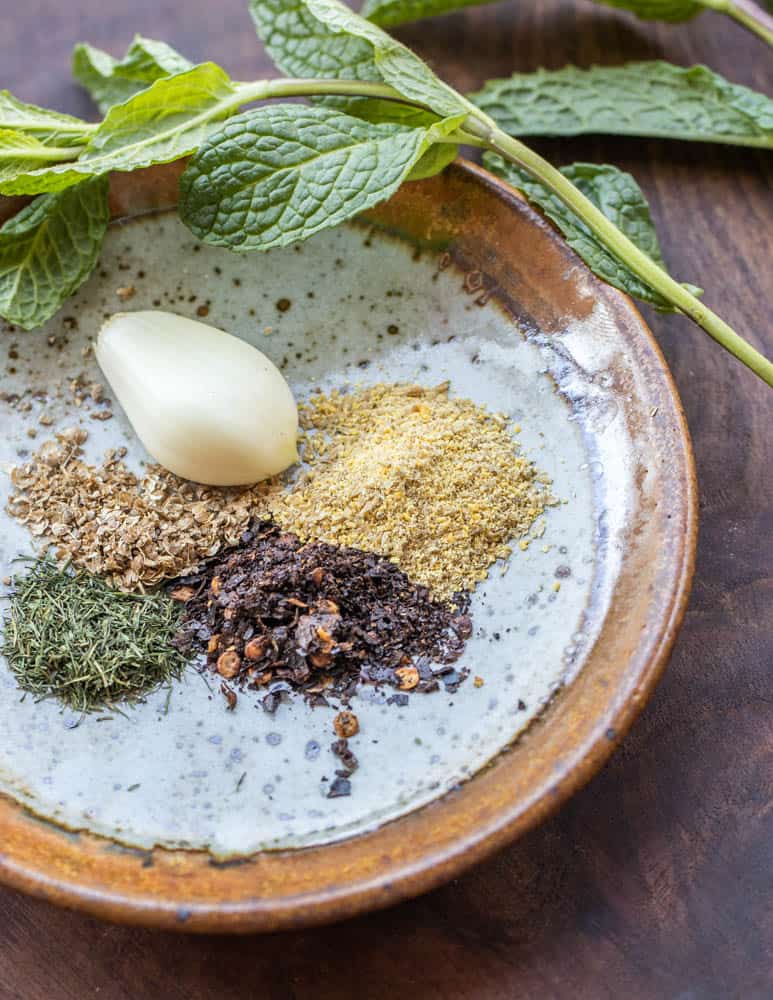
Reading a few books on Georgian Cuisine, especially Dara Goldstein's, and watching YouTube videos of Georgian ladies making Tkemali sauce showed me a few other useful things, specifically how to separate the flesh of wild plums from the skin and seeds using a colander when making Tkemali sauce.
Tkemali had a quick blip on the culinary radar a few years ago, but people seem to quickly forget about it. When I read that the sauce was made from a sort of wild plum in the region, I had to see how I could fashion a version from Prunus americana and Prunus nigra.
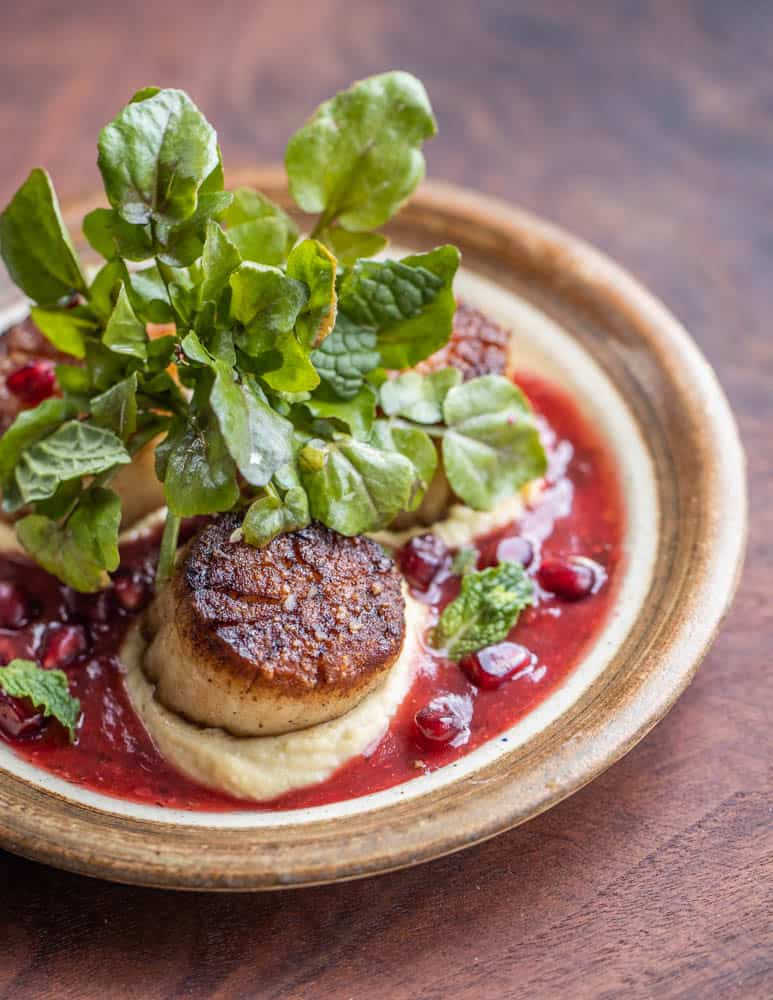
I tried to make a version that was delicious, I even served some of them to small groups to test the waters and brought it in for my line cooks to taste. I also ordered plenty of bottles of the commercial Tkemalis to test to make sure I had the seasoning blend right (it's a stripped-down variation on the Georgian spice mixture called Khumeli Sunneli that I use to make Kharcho).
Quick aside, the commercial Tkemalis are delicious and addictive, and worth trying if you like tasting food out of your comfort zone. Pomona is my favorite brand.
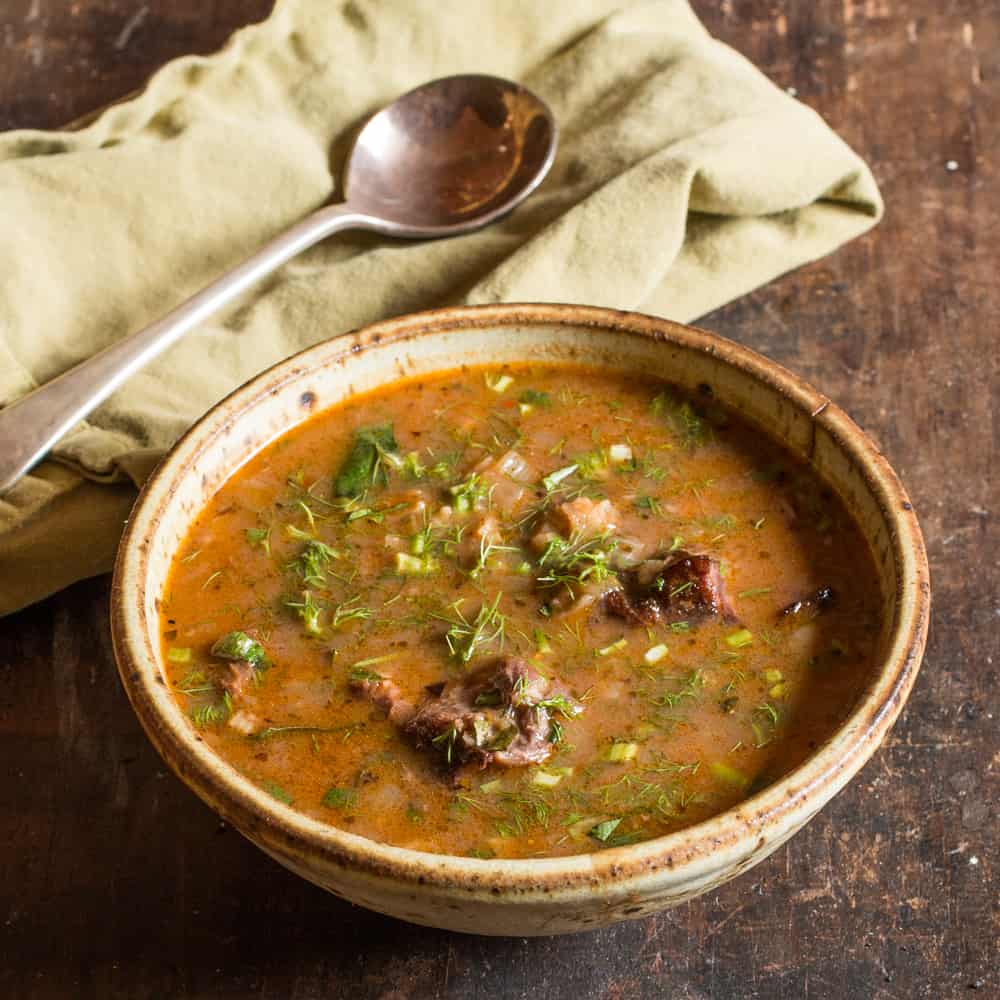
Wild plums didn't work
I tried in vain to make wild plum Tkemali for 3 years. The problem is that the species of wild plum I've worked with are just too tannic. Unripe, overripe, in-between, perfectly ripe, unripe and fermented, fermented, dried, rehydrated and boiled—I tried it all.
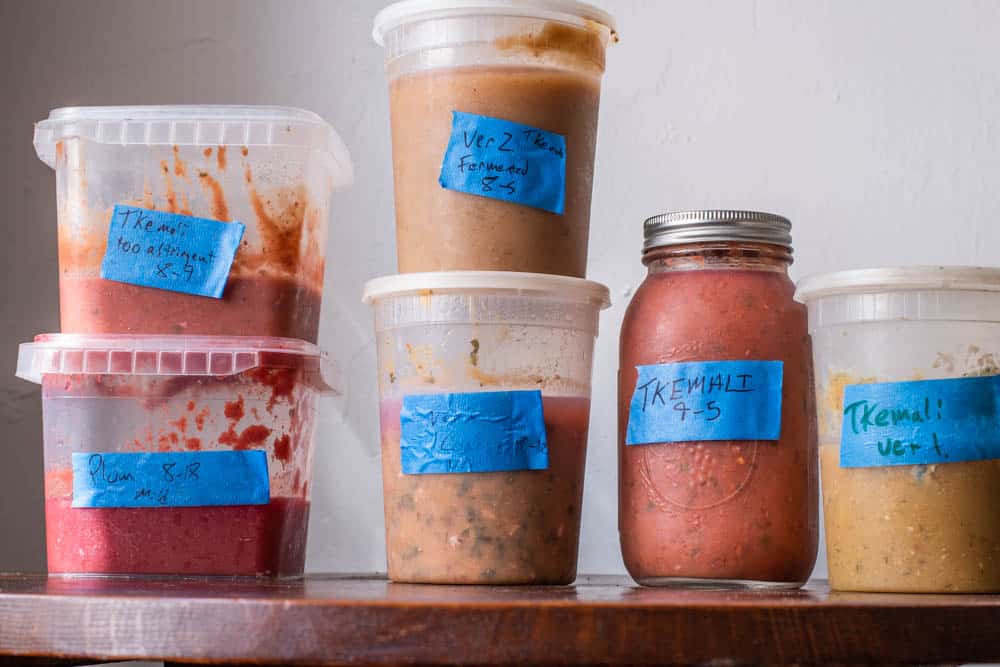
Some of the versions were ok, the tartness was on-point, but they weren't good enough for me to share with people and say: "here's something interesting you can make and enjoy", they were just too tannic.
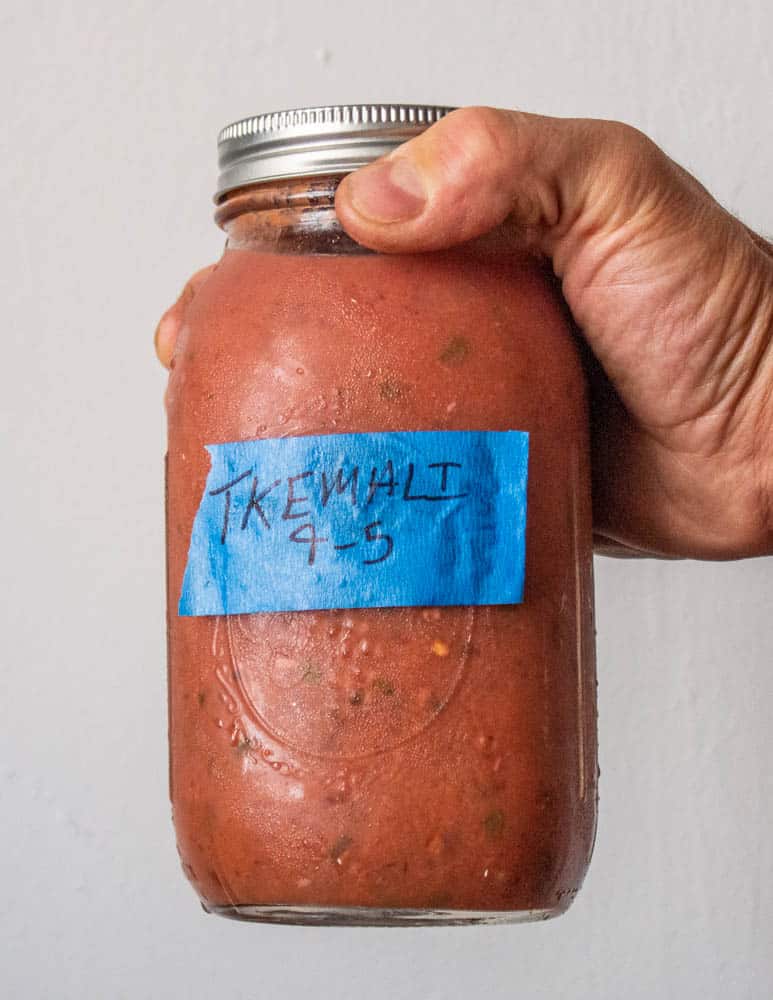
Then, this year, Sam Thayer dropped a metric ton (approximately) of his highbush cranberry cultivars on me. Sam's named 3 so far-each one superior to the Viburnum trilobum, which is itself superior to the foul-tasting European Viburnum opulus that's widespread and said erroneously sold by nurseries (and even the D.N.R.) as a native North American food plant.

As I juiced the berries, I reduced some of the finished juice down to save freezer space when it hit me.
Tasting the deep red juice, reveling in the deep tartness and thickness that came from cooking off the water, I realized that the substrate for a North American Tkemali had been sitting in front of me the whole time.
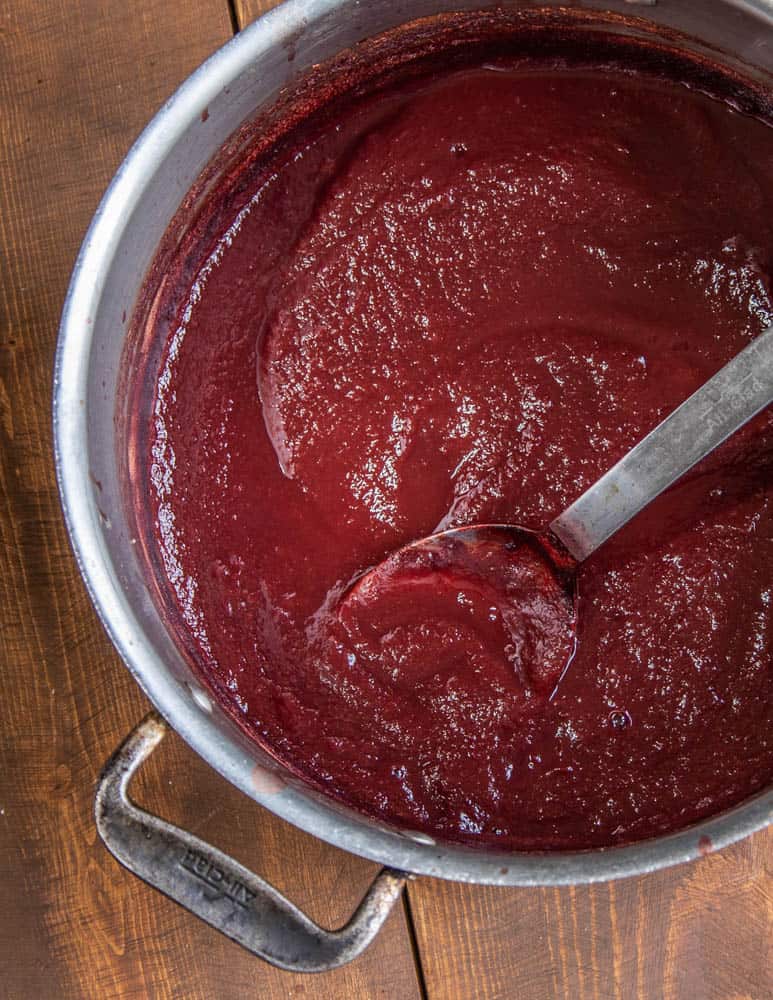
Highbush cranberries would give me the tartness I wanted that mimics the Tkemali plum, without the aggressive tannins from my local wild plums.
From there, all I had to do was plug in the spice mixture (at least I got that dialed in after 3 years!) and I was off to the races. The finished sauce is a good condiment for vegetables, seafood and chicken, and can hold up to pork, too.
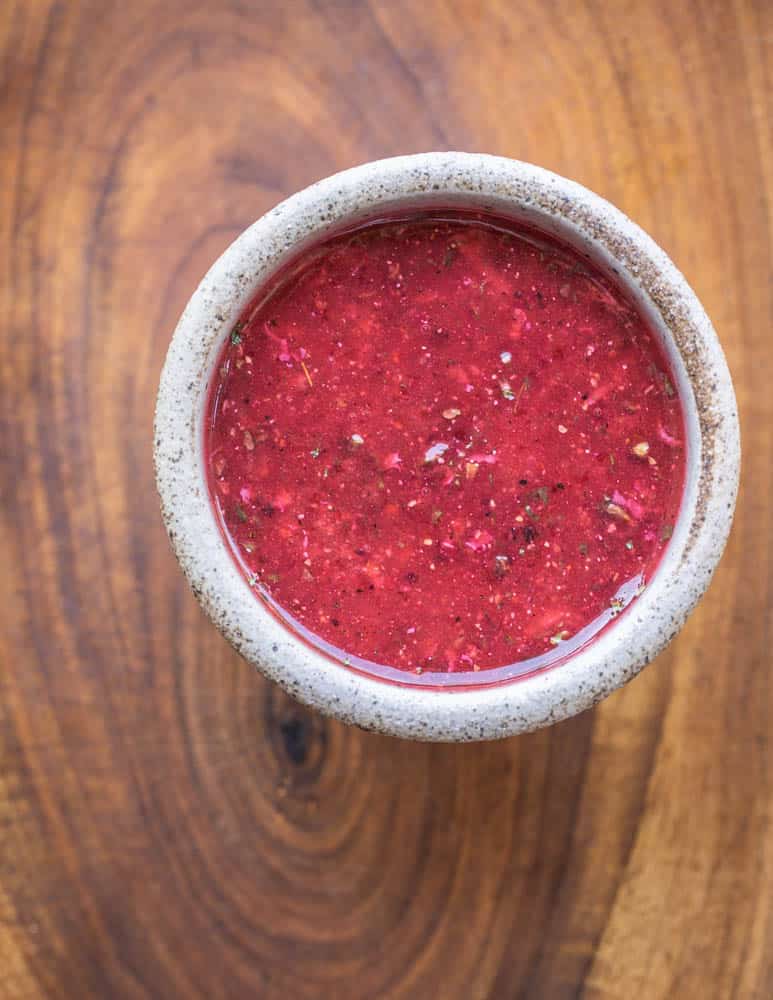
Foraged Highbush Cranberry Tkemali Sauce
Ingredients
- 16 oz thick highbush cranberry juice*
- ½ teaspoon crushed red pepper flakes or equivalent
- 2 teaspoons 14 g salt or (3% salt to highbush cranberry juice)
- ¼ teaspoon dried dill
- 2 large 12 g cloves garlic grated or minced
- 10 fresh mint leaves coarsely chopped
- Small handful of fresh cilantro coarsely chopped
- ½ teaspoon dried fenugreek
- ¼ teaspoon coriander seed
- Fresh lemon juice to taste
Instructions
Activate the chilies
- Heat the highbush cranberry puree and chili flakes until hot and steaming, then cool to room temperature.
Mix the sauce and allow it age
- Combine the cooled highbush cranberry puree with the remaining ingredients and allow to ferment, covered, at room temperature for 3-4 days, then refrigerate.
- It may be difficult to notice fermentation, and in reality, it may not ferment that much, so don't worry. The maceration at room temperature also serves to imbue the highbush cranberry puree with the flavors of the spices and herbs.
- The sauce should be tart, fenugreek forward, and mildly spicy. If you'd like it more spicy, increase the chilies accordingly.
- The finished Tkemali will last for a long time in the fridge, and can be canned in a water bath, (12 minutes for pints).
Notes
Seared Scallops with Tkemali, Hummus, and Pomegranite
Ingredients
- 12 oz Sea Scallops, preferably u-10 size
- Kosher salt, as needed
- ¼ cup high heat cooking oil or ghee
- ½ cup highbush cranberry kemali sauce warmed
- ½ cup hummus your favorite brand, just make sure it's unflavored
- a handful of fresh watercress, cleaned and dried (optional)
- Fresh torn mint leaves, to garnish optional
- Pomegranite seeds, to garnish optional
Instructions
- Pat the scallops dry well and let them sit covered with paper towels in the fridge for an hour before you cook them to ensure they're dry. this is especially important with frozen scallops, which can be good.
- Inspect the scallops you will cook and choose which side will look more attractive when it's seared--the attractive side of each scallop is the plating side, and the one you will sear.
- Heat a heavy skillet with the fat until smoking. Turn on a fan or hood vent, or open a window to help it not get smoky. Alternately, heat a cast iron pan in the coals of a grill outside.
- Season the scallops on the plating side, then put them plating side down in the ripping hot skillet. Make sure to use a large pan (12 inches in size will be good) to make sure the scalllops do not touch.
- Cook the scallops on high heat, without touching them, until you can see a touch of brown around the edges. This should take at least 5 minutes. Using a pair of tongs, peek until the side of the scallops and judge the color. You are looking for a mohogany crust here, not some blonde, yellow B.S. sear.
- When the scallops have a solid sear on them, turn the heat to medium, then flip them over in the pan to just kiss the other side. Attempting to brown both sides of the scallops will ensure your home-cooking keeseter will overcook them.
- Meanwhile, heat up a few plates, then put a spoonful of hummus in three spots on each plate to act as a bed for the scallops. Put a scallop on each dollop of hummus, then spoon the Tkemali sauce around.
- Toss the watercress with olive oil, salt, pepper, and a touch of lemon juice to taste, and arrange a few sprigs in the middle of each cluster of scallops. Finish by sprinkling on a few pomegranate seeds and torn mint leaves. Serve.

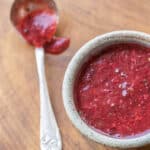

Tom
I'm getting mixed signals from the wording here, are you using juice or puree? Should I strain my cranberries through a cheesecloth and reduce that down, or should I run it through a food mill? Thank you!
Alan Bergo
This is discussed in the recipe notes. Ideally you'll mash them and put through a food mill but as most people process them into juice I include methods for using both here. Start with a small batch.
gita
I harvested some American native highbush cranberry from we bought back 20 years ago from a bare root nursery in Montana called Lawyers, they are now out of business. however these berries do smell somewhat how do you say rank when they are boiled down but the juice itself has not any of that flavor, in fact delicious and i used it to make lollipops. I want to try this recipe but are you saying that cooking them will smell sweet and delicious too? Maybe i have the other variety by mistake, although i did do a visual inspection based on a description of leaf petioles and it seemed good, but seriously a very hard to tell difference marking.
Alan Bergo
Hi Gita. All varieties of HBC will have a little funk to them, but the European one taste bitter and foul, literally it tastes like a wet dog smells. The thing you'll notice right away is that they're bitter, native HBC are not, or only very slight. Native HBC from North America only have a hint of the funky smell, and it isn't offensive at all in finished products like jellies and preserves. All varieties will have a noticeable aroma when cooking, but the North American version is tolerable.
cKaty
I'm so glad you posted this. I'm living in Tbilisi now and the food and the people are just lovely. This is a place that everyone should see once the world returns to some semblance of normal. But no Russian required. Thanks!
Alan Bergo
Thanks Katy.
Flanman
Alan- I don’t find hb cranberry a lot in Western NY but we have a TON of autumn olive (Elaeagnus umbellata) which makes a nice tart jam. Do think this recipe would work for autumn olives? I realize it’s not the same flavor but they do have a funky tart taste and people like the jam - especially with cheese. Love to give this a shot next fall using those. I cook them down a bit and then run them through my tomato strainer to get the seeds out - then destroy the seeds by cooking the crap out of them. It’s an invasive species and picking berries and then destroying them helps mitigate the spread.
Thanks!!!
Alan Bergo
Hey David. I'd think that autumn olive would work fine for this, if it needs some tartness, just adjust it with lemon at the end. You could do this with just about any tart red fruit you can make a thick coulis out of. Someone suggested rhubarb today and I'm going to try that this year for sure, it would have a texture more similar to the plums, which is a bit thready/thick.
Elizabeth Blair
Exciting Alan. Plenty of wild highbush cranberries near my cabin and I have been wanting to find a way to use them. Doubt there are the European invaders you mention. They're i n the forest. Looking forward to trying this Georgian "Ketchup" in the fall. Thank you!
Alan Bergo
Elizabeth, nice to hear from you. Up near your cabin is their prime habitat, and I see mostly Native species up there. One taste will tell you: if it's bitter and tastes like wet dog, it's no good. Easy to differentiate.
Gilbert
Chokecherries that grow here, Grand Marais area, don't seem extremely tannic to me. I cook them or kalinka (hb cranberries) then macerate them with food mill. Need to use the right sieve plate and adjust the spring so seeds don't come flying out like popcorn.
Alan Bergo
Chokecherries are beyond the scope of this post. I loved learning the name kalinka from my friends from Eastern Europe. They cook with Viburnum opulus and I just cannot understand how anyone could make it taste good. I sure tried.
Gilbert
The song is going through my head... Kalinka moya, the unofficial national anthem of Russia, also mentions malinka, raspberry.
Chokecherries, Prunus virginiana vs "I had to see how I could fashion a version from Prunus americana and Prunus nigra."
Something else I learned from Russian food culture, the leaves and growing branch tips of some fruit trees and bushes are delicious. Black currant especially. Water extract, no alcohol needed.
Alan Bergo
Ah, I see! Thanks for clarifying. I keep forgetting to try the young meristems (growing tips) of cherry trees. I know they're pickled in Japan, and there's a famous avante-garde distillery called Empirical that's using them to flavor liquors.
David Britton
Lord luv ya for tryin', Alan. I'm gonna do this. But you really need to disclose to those uninformed about the properties of Highbush Cranberries -- just how old-wet-wool-worksock-smelly their whole house will be when they boil up the berries! My wife!! ... well that's best left unsaid. Let's just say I pick my occasions and locations more carefully. 😉
Alan Bergo
David, you're mistaking Viburnum opulus for Viburnum trilobum. I'm cooking with Virburnum trilobum, and three different cultivars Sam Thayer has propagated. Sam's cultivars specifically have giant fruit, and far less of any funky taste than even V. trilobum, which tastes fantastic compared to the one you're describing. If you tasted V. opulus and hated it, like I did, you owe it to yourself to find the species that actually taste good. Viburnum opulus tastes like bitter wet dog, the others taste like tart berries. Good tasting highbush cranberries exist, and Sam is now supplying the DNR with truly native varieties. Unfortunately the European imposter that tastes so awful is the only species most people know.
Carla Beaudet
Do you happen to know whether Sam is selling V. trilobum cultivars?
Alan Bergo
Carla, yes he sells them. The ones pictured here are called Flag River, and the berries were nearly the size of grapes. As far as I know he only sells them in person. He typically brings some to the Wild Harvest Festival in Sept.
Alan Bergo
I'll add too, that I don't cook the fruit while I process it, I use a cold extraction/juicing so there isn't any noticeable smell.
Ellen
I realize Zirbenschnapps wasn't the main topic of this post, but I've never heard anyone else mention it! I made some from immature ponderosa cones a few summers ago. It's got a crazy red color. Still trying to figure out how to use it best.
Alan Bergo
Of course you know Zirbenschnapps! I learned about it from a famous wine importer I did a talk with a few years ago. Currently I only know one restaurant that serves it in MN. We were working on a version to sell commercially with my booze project (that I still haven't shared here) and the distillates were coming out perfectly clear, which is obv what distillates do, and not how Z shnapps is supposed to look. Capturing the red color of it was tricky, and for whatever reason my P. resinosum cones weren't doing a great job. I discovered some ornamental Siberian pine cones last year though and they're the best I've tasted, you could *almost* take a bit out of them straight up. Hopefully a simple maceration gives us the red color and the Siberian cones a more mild result. Was yours super duper astringent? Did a simple maceration keep the red color?